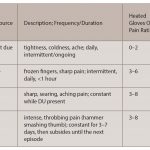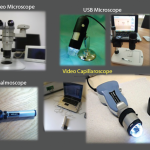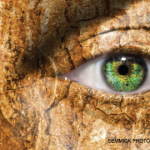The study intervention was battery-operated heated glove liners (Motion Heat, Calgary, Canada), referred to as gloves in this article. The gloves are heated by non-metallic fibers woven into the gloves and connected to 12-volt rechargeable lithium batteries. The batteries are housed in a zippered pocket in each cuff. In addition to the portable batteries, wall and car adapters were used to power the gloves. Three settings of 84ºF, 104ºF and 122ºF were adjusted as often as needed to ensure a comfortable level of heat as determined by the wearer. The gloves provided continuous heat from the dorsum of the hand to the tips of the fingers and thumbs.
Primary Outcome Measures
Pain: The numeric rating scale (NRS) is an 11-point rating scale with 0 being no pain and 10 being the worst imaginable pain. It has excellent test-retest reliability (r = 0.95) for chronic pain when four ratings per day are taken daily for seven days.29-31 A single measure of pain is not a reliable or valid measure of pain in patients with chronic pain. To maximize reliability and validity of pain measures, averaging multiple measures across time is important.29 Construct validity (r = 0.94, 95% CI = 0.93–0.95) was high, with excellent correlation between NRS and visual analog scale.32 Farrar et al reported that a reduction of two points represented a clinically important improvement in chronic pain.33
Ischemic Digital Ulcers: Digital pitting scars and digital ulcers are two digital lesions resulting from ischemia due to Raynaud’s and dSSc vasculopathy.10 Digital pitting scars are small pits and areas of hyperkeratosis on the finger.10 They can be precursors to DUs. An ischemic DU is defined as a denuded area with well-demarcated borders, involving loss of epidermis and dermis, located distal to the proximal interphalangeal joint on the pulpar surface of the fingertip.14,18 Traumatic ulcers, located on the extensor surfaces of the digits, are not addressed in this article because they are not classified as ischemic DUs.14
Secondary Outcome Measures
Strength: Using the standardized test protocol for hand and pinch strength recommended by Mathiowetz et al, grip strength was measured with a hydraulic hand dynamometer (Baseline, White Plains, N.Y.).34 The hand dynamometer has a concurrent validity of 0.9994 and 0.9997 before and after study with known weights in healthy adults.35 Pinch was measured with a hydraulic pinch gauge (JAMAR, Sammons Preston Inc.).
Active Range of Motion: Goniometers were used to measure flexion and extension of bilateral wrists and 2nd and 5th digits, using the procedures described by Norkin and White.36 Intrarater reliability of the Roylan finger goniometer is good with ICC 0.67–0.85 for active ROM.37


